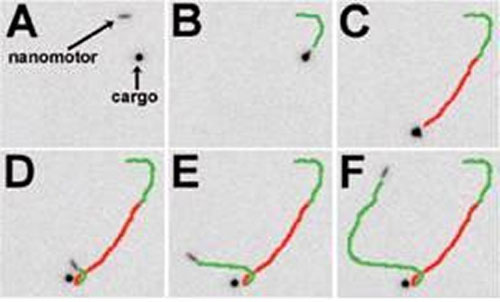| Sep 24, 2011 |
Remotely manipulating nanoparticles to lift, drag, release cargo
|
|
(Nanowerk News) A research team has succeeded in remotely manipulating metal nanoparticles to lift, drag and release cargo in water.
|
|
Understanding the physics of swimming nanoparticles--a thousand times smaller than a human hair--enables scientists and engineers to design and implement future generations of functional nano-swimmers. The tiny "motors" could someday deliver drugs to cancerous tumors, clean contaminated water or sense hazards in the environment.
|
 |
| Catalytic nanoparticle swimming towards a piece of cargo. The motor picks up the cargo (green), drags it through water (red), and drops it off (green).
|
|
Swimming microorganisms such as bacteria are seen in nature, but have few man-made analogues. But man-made nanoparticles with two different metal segments (such as gold and platinum) will swim in water when a fuel, such as hydrogen peroxide, is present. The particles are so small that a billion of them can be contained in a single tear drop.
|
|
The researchers from Arizona State University and University of California, San Diego, directed the particles remotely with magnetic fields and got them to pick up, haul and release cargo 30 times their size. The nanomotors also swam at more than 100 body lengths per second. Respectively, these feats are equivalent to a person pushing a school bus and a Corvette racing at 1022 mph. The researchers also were able to trigger collective swimming, akin to schooling behavior seen in biological organisms.
|
|
The research sheds light on the movement of particles, developing a mathematical model that uses fluid mechanics and electrochemistry to show that fuel reactions at the metal surface generate an electric field, which drives the fluid around the particle and propels it forward--much as an oar pushes water back and a kayak forward.
|
|
These results are from an NSF-funded project "Collaborative Research: Rationale Design of Enhanced Catalytic Nanomotors" at Arizona State University.
|

